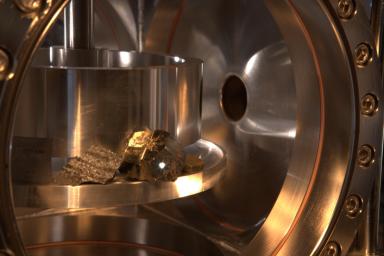
|
Spark Generated by ChemCam Laser During Tests
- Click the image above for a larger view
- Full-Res JPEG (4386 x 2920) (772.8 kB)
- Full-Res TIFF (4386 x 2920) (38.4 MB)
Caption:
The ChemCam instrument for NASA's Mars Science Laboratory mission uses a pulsed laser beam to vaporize a pinhead-size target, producing a flash of light from the ionized material -- plasma -- that can be analyzed to identify chemical elements in the target.
This image from testing of ChemCam shows a ball of luminous plasma erupting from the surface of an iron pyrite crystal in the sample chamber approximately 3 meters (10 feet) from the instrument. The laser beam itself is invisible.
Background Info:
ChemCam was conceived, designed and built by a U.S.-French team led by Los Alamos National Laboratory in Los Alamos, N. M.; NASA's Jet Propulsion Laboratory in Pasadena, Calif.; the Centre National d'Études Spatiales (the French government space agency); and the Centre d'Étude Spatiale des Rayonnements at the Observatoire Midi-Pyrénées, Toulouse, France.
JPL, a division of the California Institute of Technology in Pasadena, manages the Mars Science Laboratory mission for the NASA Science Mission Directorate, Washington. This mission will land a rover named Curiosity on Mars in August 2012. Researchers will use the tools on the rover to study whether the landing region has had environmental conditions favorable for supporting microbial life and favorable for preserving clues about whether life existed.
Cataloging Keywords:
| Name | Value | Additional Values |
|---|---|---|
| Target | Mars | |
| System | ||
| Target Type | Planet | |
| Mission | Mars Science Laboratory (MSL) | |
| Instrument Host | Curiosity Rover | |
| Host Type | Rover | |
| Instrument | ||
| Detector | ||
| Extra Keywords | Color | |
| Acquisition Date | ||
| Release Date | 2010-09-21 | |
| Date in Caption | ||
| Image Credit | NASA/JPL-Caltech/LANL | |
| Source | photojournal.jpl.nasa.gov/catalog/PIA13399 | |
| Identifier | PIA13399 | |
